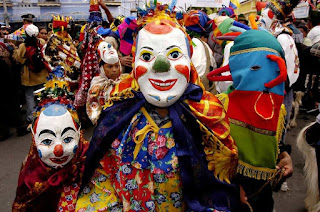Ecuador culture people food and festivals
The first thing to realize about Ecuadorian culture is that it is not one single culture. Instead it is a whole range of cultures mingled together, representing every level of this very stratified community. Ecuador's official language is Spanish, but Quichua - an Incan language - is spoken by the Indian population.
The cultures of the indigenous people are rich and varied, but there are commonalities across languages and societies. The Quichua (pronounced Kéechua) speakers of the Andes and Amazonia are differentiated from one another, but come together when common causes arise. Quichua includes the northern dialects of Quechua, the language of the imperial Inca. In Quichua and Quechua people identify as Runa ("fully human"), and their language asruna shimi("human speech").
All of the nationalities identify in their own languages as both fully human beings and as Ecuadorians. There is no word resemblingindio("indian") in indigenous languages, and the use of that term is deeply resented. In Spanish, the term for indigenous person (indígena) is preferred, thoughgente(person, human being) is the most appropriate designation for any Ecuadorian. People throughout Ecuador make it very clear that identification as Ecuadorian is for all people, and is not only for the elite and upper–middle classes.
Pre–Inca indigenous existence—which is important to the concept of national culture in Ecuador—is difficult to unravel, but it was rich in its diversity, complex in its multiplicity of polities, and left an archaeological record that differentiates its cultures from others in South America. The Incaic period, to which most Ecuadorians refer when discussing the indigenous past, began about 1480 and ended fifty years later with the Spanish conquest led by Francisco Pizarro and Diego Almagro. The Inca, whose northern leader in the 1530s was Atahualpa, probably introduced Quechua, as Quichua, into Andean Ecuador, and they certainly promoted its usage as a political lingua franca. The Spaniards introduced their language as they imposed colonial rule, but Quichua continued to spread.
As the Spanish took over Quito, began the exploration of Amazonia, and sought to establish a viable Pacific port, African-American people began their own conquest of the northwest rain-forest region of what is now Esmeraldas. By the mid– sixteenth century, self-liberated Africans and their offspring controlled what was known as the Zambo Republic (zamborefers to intermixture of African and Native peoples). As Quito became a royal court system of the Spanish crown in 1563, it extended bureaucratic control westward to the northwest coast and eastward to the Upper Amazon. In both areas full-scale revolts occurred, with the "Zambos" of the northwest coast and the Quijos and Jivaroans of the Amazonian region resisting all attempts of Spanish incursion. The Spanish were forced to make alliances with the representatives of the Zambo Republic to the west; they managed to subdue the Quijos in the north Amazonian territory, but not the Jivaroans in the center and south Amazonian regions.
Food in Daily Life.The most basic, ubiquitous prepared food is soup, with many variations according to region and ingredients. Coastal fish and coconut milk chowders, sierran potato–based soups, and Amazonian pepper–pot dishes are joined by chicken consommé, cream of avocado, and cow's foot and tripe soup. The mildly fermentedchichamade from manioc by indigenous people of Amazonia could be regarded as a soup in its daily, nonceremonial consumption. Other common nonfermented food drinks are made with barley and oatmeal.
The middle and upper classes follow a European model of diet and dining: the primary meal, dinner, features several courses, is served at 2:00P.M., and may last for two hours. First comes the soup, and then thesegundo("second") orseco("dry") courses. It is a time to gather with family at home, or to meet friends or business acquaintances at a restaurant. Workers who travel far from home may take along lunch in a vertically compartmentalized lunch bucket, or buy inexpensive hot food from kiosks or street vendors. These foods include potato and meat soups or stews,choclos(corn on the cob), small sausages fried with onions and potatoes, and eggs. Other national favorites from the street to restaurants includeempanadas, small meat, vegetable, or corn pies; shrimp, bivalves, fish, pork, or beef specialties; and "typical" dishes such aslocro, a potato and cheese soup, andllapingachos, potato– cheese fritters. In urban Quito and Guayaquil one may choose food from Arby's, Domino's Pizza, Kentucky Fried Chicken, McDonald's, or TGI Friday's. A small number of caterers specialize in home–delivered prepared meals to accommodate employed women. Abundant fresh fruits and fruit juices are extremely popular.
About 14 million people call Ecuador home. Each of the different regions boast different lifestyles and customs. The people can be very superstitious.
|
The official language is Spanish. There are several indigenous languages spoken, including Shuar and several variations of Quichua. English is taught in schools, though teachers aren't usually fluent themselves, so most people have only a very basic knowledge of English.





















No comments:
Post a Comment